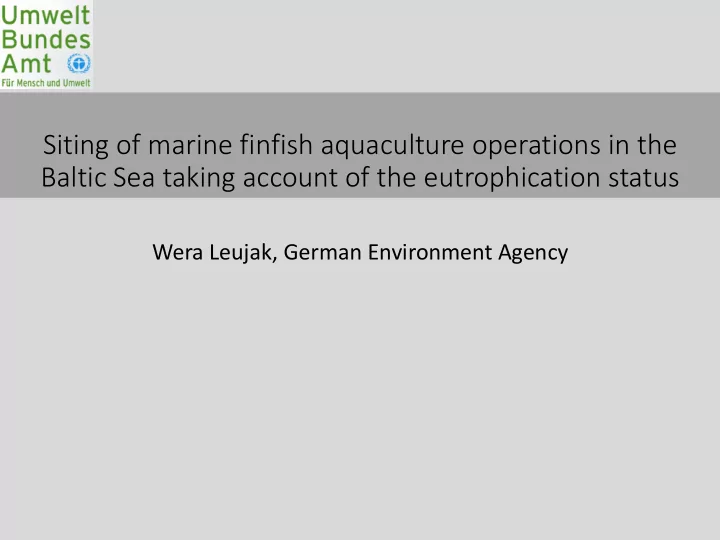

Siting of marine finfish aquaculture operations in the Baltic Sea taking account of the eutrophication status Wera Leujak, German Environment Agency
Possibilities for siting • In general, there are 3 possibilities for siting finfish aquaculture operations taking account of the eutrophication status of the Baltic Sea Considering the eutrophication status of the basin Considering the maximum allowable inputs for basins Considering the country-allocated reduction targets • These possibilities differ in their degree of precaution
1) Considering the eutrophication status • According to the HOLAS II Source: HELCOM 2018 assessment of the eutrophication status, based on data from 2011- 2016, 97% of the Baltic Sea are eutrophied • The whole open Baltic Sea is eutrophied and 86% of the coastal waters • This would leave an area of only 3% of the Baltic Sea where finfish aquaculture could be established (some Swedish, Finnish and Danish coastal waters) • Taking the eutrophication status into account constitutes the most precautionary approach, since the focus is on the actual status of the sea, which is based on many different indicators
2) Considering the Maximum Allowable Inputs (MAI) • MAI have been agreed at the 2013 Copenhagen Ministerial Meeting • Are based on a modelling approach (BALTSEM model of the Baltic Nest Institut) and on the eutrophication targets (nutrients, chlorophyll-a, secchi depth, oxygen) • Are supposed to constitute the maximum airborne and waterborne input of nutrients the Baltic Sea Basins can tolerate before eutrophication effects occur • Annual follow-up in HELCOM
2) Considering the Maximum Allowable Inputs (MAI) • Rec 37/3 refers to MAI as follows : „ permits or Source: HELCOM 2018 regulations should aim at limiting emissions and discharges of phosphorus and nitrogen, thus striving to contribute, together with other sectors, to keeping the inputs within the Maximum Allowable Inputs as agreed in the HELCOM Ministerial Declaration 2013 (and following updates) in order to enable and not jeopardize the achievement of a good environmental/ecological/che mical status …” There are currently 3 basins where MAI are not exceeded with statistic certainty – Bothnian Sea, Danish Straits and Kattegat
2) Considering the Maximum Allowable Inputs (MAI) 115 tons below MAI 27 tons below MAI 181 tons below MAI • The margin to MAI is small, especially for phosphorus • According to the precautionary principle there should not be an increase in nutrient inputs • HELCOM CPs also committed in the Ministerial Declaration 2013 to implement nutrient reductions even if the modelling approach taken did not establish reduction requirements • MAI constitute a good yardstick for the management of nutrient inputs but should not be taken as absolut numbers that can be safely filled-up • The approach is less precautionary because the MAI are based on a modelling approach • At least MAI ensure a collective sharing of nutrient reductions
3) Considering the Country-Allocated Reduction Targets (CART) • CART have been agreed at the 2013 Copenhagen Ministerial Meeting • Are based on the same approach as MAI; to obtain CART the needed reductions have been distributed among all CPs sharing a basin based on the polluter pays principle • Based on CART, input ceilings can be calculated as follows: Input ceiling = net reference inputs – CART • There is a regular follow-up of the input ceilings in HELCOM
3) Considering the Country-Allocated Reduction Targets (CART) Input ceiling fulfillment for nitrogen by 2014 Input ceiling fulfillment for phosphorus by 2014
3) Considering the Country-Allocated Reduction Targets (CART) • Finfish aquaculture could be established by those CPs that have fulfilled their CART für phosphorus and nitrogen for a certain basin if the nutrient discharge from the aquaculture operation will not lead to an exceedance of the nutrient inputs ceilings (if extra reductions exist) • This would constitute the least precautionary approach since it will be assumed that all CPs can achieve their CART for a respective basin
Conclusion • It is recommended to base the site selection for finfish aquaculture operations in the Baltic Sea on the eutrophciation status of the respective location • If the status is not good, new finfish aquaculture operations should not be established
Recommend
More recommend